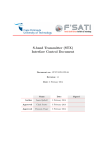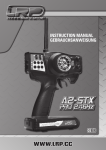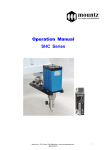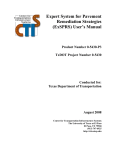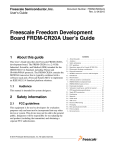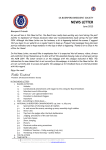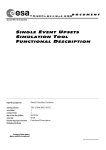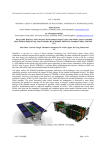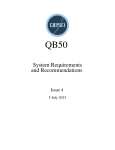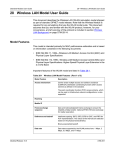Download User Manual: S-band Transmitter (STX)
Transcript
User Manual: S-band Transmitter (STX) Document no.: CPUT-UM-STX-01 Revision: 1.6 Date: 28 February 2014 Name Date Author Jason Quibell 28 February 2014 Author Charl Jooste 28 February 2014 Francois Visser 28 February 2014 Approved Signed Document Control Rev. Date Section 1.0 26 July 2012 1.1 14 September 2012 1.2 28 January 2013 1.3 28 March 2013 All Hardware and data interfacing Data interfacing Data interfacing and test procedures 1.4 1.5 1.6 16 September 2013 27 November 2013 28 February 2014 Description of Change Reason for Change First Release Additional information Additional information Buffer size increased in software version 1.2 Additional information Software version 1.3 Additional information Additional information Additional information All All All Hardware update Hardware update Software update Revision Control Product Part Number Revisions Covered S-band Transmitter CPUT-STX-01 1.7 Notes Related Documents No. Document Name CPUT-ICD-STX01 STX Interface Control Document CPUT-TR-STXxx STX Test Results Document Document Reference i Contents Document Control i Revision Control i Related Documents i Nomenclature vi 1 Introduction 1 2 Overview 2.1 Encoding and modulation overview . . . . . . . . . . . . . . . . . . . . . . . . . . 1 2 3 Absolute maximum ratings 3 4 Electrical characteristics 4 5 Mechanical characteristics 5.1 Specifications . . . . . . . . . . . . . . . . . . . . . . . . . . . . . . . . . . . . . . 5.2 Materials . . . . . . . . . . . . . . . . . . . . . . . . . . . . . . . . . . . . . . . . 5.3 Mechanical configuration . . . . . . . . . . . . . . . . . . . . . . . . . . . . . . . . 5 5 5 5 6 Handling and storage 6.1 Power amplifier protection 6.2 Antenna impedance . . . 6.3 ESD protection . . . . . . 6.4 General handling . . . . . 6.5 Storage and shipping . . . . . . . . 7 7 7 7 7 8 7 System operation 7.1 Method of operation . . . . . . . . . . . . . . . . . . . . . . . . . . . . . . . . . . 7.2 Telemetry data . . . . . . . . . . . . . . . . . . . . . . . . . . . . . . . . . . . . . 9 9 9 . . . . . . . . . . . . . . . . . . . . . . . . . . . . . . . . . . . . . . . . . . . . . . . . . . . . . . . . . . . . . . . . . . . . . . . . . . . . . . . . . . . . . . . . . . . . . . . . . . . . . . . . . . . . . . . . . . . . . . . . . . . . . . . . . . . . . . . . . . . . . . . . . . . . . . 8 Hardware interfacing 11 8.1 CSK header connections . . . . . . . . . . . . . . . . . . . . . . . . . . . . . . . . 11 8.2 RF connector . . . . . . . . . . . . . . . . . . . . . . . . . . . . . . . . . . . . . . 12 8.3 STX enable . . . . . . . . . . . . . . . . . . . . . . . . . . . . . . . . . . . . . . . 12 9 Data interfacing 9.1 Modes of operation . . . . . . . . . . . . . . . . . . . . 9.1.1 Configuration mode . . . . . . . . . . . . . . . 9.1.2 Synchronisation mode . . . . . . . . . . . . . . 9.1.3 Data mode . . . . . . . . . . . . . . . . . . . . 9.1.4 Test data mode . . . . . . . . . . . . . . . . . . 9.1.5 Recommended procedure for transmitting data 9.2 I2 C registers . . . . . . . . . . . . . . . . . . . . . . . . ii . . . . . . . . . . . . . . . . . . . . . . . . . . . . . . . . . . . . . . . . . . . . . . . . . . . . . . . . . . . . . . . . . . . . . . . . . . . . . . . . . . . . . . . . . . . . . . . . . . . . . . . . . 13 13 13 13 13 14 14 15 9.3 9.2.1 Register 0x00: Control register . . . . . . . . . . . . . . . . 9.2.2 Register 0x01: Encoder register . . . . . . . . . . . . . . . . 9.2.3 Register 0x02: Debug register . . . . . . . . . . . . . . . . . 9.2.4 Register 0x03: PA power level register . . . . . . . . . . . . 9.2.5 Register 0x04: Synth offset register . . . . . . . . . . . . . . 9.2.6 Register 0x05: Reset register . . . . . . . . . . . . . . . . . 9.2.7 Register 0x11: Firmware version register . . . . . . . . . . . 9.2.8 Register 0x12: Status register . . . . . . . . . . . . . . . . . 9.2.9 Register 0x13: Transmit ready register . . . . . . . . . . . . 9.2.10 Register 0x14 & 0x15: Buffer underruns register . . . . . . 9.2.11 Register 0x16 & 0x17: Buffer overruns register . . . . . . . 9.2.12 Register 0x18 & 0x19: Buffer count register . . . . . . . . . 9.2.13 Register 0x1A & 0x1B: RF output power register . . . . . . 9.2.14 Register 0x1C & 0x1D: PA temperature . . . . . . . . . . . 9.2.15 Register 0x1E & 0x1F: Board temperature sensor (top) . . 9.2.16 Register 0x20 & 0x21: Board temperature sensor (bottom) 9.2.17 Register 0x22 & 0x23: Battery current register . . . . . . . 9.2.18 Register 0x24 & 0x25: Battery voltage register . . . . . . . 9.2.19 Register 0x26 & 0x27: PA current register . . . . . . . . . . 9.2.20 Register 0x26 & 0x27: PA voltage register . . . . . . . . . . SPI Interface . . . . . . . . . . . . . . . . . . . . . . . . . . . . . . 9.3.1 Transmit Ready . . . . . . . . . . . . . . . . . . . . . . . . . . . . . . . . . . . . . . . . . . . . . . . . . . . . . . . . . . . . . . . . . . . . . . . . . . . . . . . . . . . . . . . . . . . . . . . . . . . . . . . . . . . . . . . . . . . . . . . . . . . . . . . . . . . . . . . . . . . . . . . . . . . . . . . . . . . . . . . . . . . . . . . . . . . . . . . . . . . . . . . . . . . . . . . . . . . . . . . . 18 18 19 19 19 20 20 20 20 21 21 21 21 22 22 22 23 23 23 23 24 24 10 Test procedures 25 10.1 Transmit full buffer with buffer emptied . . . . . . . . . . . . . . . . . . . . . . . 25 10.2 Continuous transmit of user data with buffer not emptied . . . . . . . . . . . . . 26 11 Special note regarding transmit power iii 27 List of Figures 1 2 3 4 5 System block diagram . . . . . . . . . . . . . . . . . . . . . . . . . . Mechanical diagram (shown in mm) [ESQ-126-13-G-D header shown] Telemetry data from STX . . . . . . . . . . . . . . . . . . . . . . . . Block diagram of the CSK header connections and system layout . . PC/104 header pinouts . . . . . . . . . . . . . . . . . . . . . . . . . . iv . . . . . . . . . . . . . . . . . . . . . . . . . . . . . . . 1 . 6 . 9 . 11 . 11 List of Tables 1 2 3 4 5 6 7 Absolute maximum ratings . . . Electrical characteristics . . . . . Mechanical specifications . . . . List of materials . . . . . . . . . PC/104 header pinout definitions I2 C register map. . . . . . . . . . Temperature sensor data format. . . . . . . . . . . . . . . . . . . . . . v . . . . . . . . . . . . . . . . . . . . . . . . . . . . . . . . . . . . . . . . . . . . . . . . . . . . . . . . . . . . . . . . . . . . . . . . . . . . . . . . . . . . . . . . . . . . . . . . . . . . . . . . . . . . . . . . . . . . . . . . . . . . . . . . . . . . . . . . . . . . . . . . . . . . . . . . . . . . . . . . . . 3 . 4 . 5 . 5 . 12 . 16 . 22 Nomenclature Abbreviations ADC Analogue-to-Digital Converter BCD Binary-Coded Decimal CSK CubeSat Kit FIFO First In First Out FPGA Field Programmable Gate Array MC Major Component OBC On Board Computer PA Power Amplifier SPI Serial Peripheral Interface STX S-band Transmitter TBD To Be Determined vi Overview CPUT-UM-STX-01 Rev. 1.6 1 Introduction This document describes the operation, handling and storage of the first generation of the Sband Transmitter (STX). The STX is an integrated RF data transmitter module supporting a maximum transmission bit rate of 2 Mbps (1 Mbps user data + 1 Mbps encoding). An overview of the STX is shown in Figure 1. STX Power Control / Telemetry VBAT Patch Antenna Power Supply I I2C RF Module RF Out Control and Data Encoder Module High-speed Data SPI Q Figure 1: System block diagram 2 Overview The STX is a compact S-band Transmitter designed for CubeSat nanosatellite missions. It is compatible with the CubeSat nanosatellite standard, with a CubeSat Kit PC/104 form factor. The STX implements QPSK or OQPSK modulation with Intelsat IESS-308 based encoding which ensures compatibility with low cost commercial ground segment receivers. The STX frequency of operation is selectable from 2.4–2.45 GHz (amateur band).The frequency of operation is user selectable within the band. The carrier frequency is adjustable in 500 kHz steps. Output power is adjustable in 3 dB steps from 21 dBm to 30 dBm. The STX is configured via an I2 C data bus and high speed payload data is sent via SPI. Data transmission rates of up to 2 Mbps are supported with 1/2, 1/4 and 1/8 rate modes. The STX is powered from the battery bus, yet may be powered down externally via an enable line from the PC/104 header. French South African Institute of Technology 1 of 27 www.cput.ac.za/fsati Overview Encoding and modulation . . . CPUT-UM-STX-01 Rev. 1.6 2.1 Encoding and modulation overview • QPSK and OQPSK modulation schemes. • Open Network Encoding scheme based on IntelSAT IESS-308 specifications. • V.35 IntelSAT scrambler. • Differential encoding. • Half-rate convolutional encoding (K=7). • Pulse shaping filter (0.35 roll-off factor). • 2 Mbps data rate with full, 1/2, 1/4, and 1/8 data rate modes. – 1 Mbps maximum user data as half-rate convolutional encoding is implemented. French South African Institute of Technology 2 of 27 www.cput.ac.za/fsati Absolute maximum ratings CPUT-UM-STX-01 Rev. 1.6 3 Absolute maximum ratings Table 1: Absolute maximum ratings Parameter Notes Value Unit Supply voltage Battery bus 14 STX EN STX enable –0.3 to 5 V Operating temperature –25 to +61 ◦C Storage temperature –40 to +85 ◦C French South African Institute of Technology 3 of 27 V www.cput.ac.za/fsati Electrical characteristics CPUT-UM-STX-01 Rev. 1.6 4 Electrical characteristics Parameter Table 2: Electrical characteristics Notes Min Typ Max Unit 6 7.2 12 V Power Input voltage Battery bus Input current Vbatt = 7.2 V 1/8 W RF power – 0.31 – A 1/4 W RF power – 0.42 – A 1/2 W RF power – 0.55 – A 1 W RF power – 0.83 – A PA off – 0.6 0.7 W 2400 – 2450 MHz 21 – 30 dBm Output return loss – 7 – dB Frequency stability – ±2.5 – ppm Channel spacing – 500 – kHz Transmission speed 50 400 500 kbps Node address – 0x26 – hex Address scheme – 7 – bit – 4 8 Mbps Idle power RF characteristics Frequency range Amateur band Output power 3 dBm increments I2 C SPI Transmission speed French South African Institute of Technology 4 of 27 www.cput.ac.za/fsati Mechanical characteristics CPUT-UM-STX-01 Rev. 1.6 5 Mechanical characteristics 5.1 Specifications Table 3: Mechanical specifications Notes Min Parameter Typ Max Unit Physical L W H Dimensions 96 90.2 17 mm Weight 90 95 100 g – PC/104 – – – SMA – – Input ports Header connector Output ports RF connector 5.2 Materials Materials Scotch-Weld Table 4: List of materials Manufacturer %TML %CVCM %WVR 3M 0.97 0.02 0.32 2216 Epoxy Application Note Adhesive Fixing B/A PCB Material FR4 0.62 0 0.1 PCB Board NASA Worst Case Solder Resist CARAPACE 0.95 0.02 0.31 Solder Mask EMP110 Solder Sn63 5.3 Mechanical configuration French South African Institute of Technology 5 of 27 www.cput.ac.za/fsati Mechanical characteristics Mechanical configuration French South African Institute of Technology CPUT-UM-STX-01 Rev. 1.6 6 of 27 www.cput.ac.za/fsati Figure 2: Mechanical diagram (shown in mm) [ESQ-126-13-G-D header shown] Handling and storage CPUT-UM-STX-01 Rev. 1.6 6 Handling and storage Specific guidelines must be adhered to when handling, transporting and storing the transmitter. Failure to follow these guidelines may result in damage to the unit or degradation in performance. Although the unit has been tested at full RF output power across the temperature range, it is advisable to fit an appropriate heat strap between the power amplifier and the chassis metal. The heat strap may be attached to the bottom side of the unit where mounting holes have been provided around the power amplifier. A heat strap may be cut from 1 mm thick copper or brass plate and fastened to the unit with M1.6 screws, washers and nuts. 6.1 Power amplifier protection Caution must be taken to ensure that an appropriate 50 Ω RF load (at least 2 W rating) is presented to the RF output of the STX while the power amplifier is enabled. Failure to do so could result in permanent damage to the power amplifier unit. 6.2 Antenna impedance Physically touching an antenna or bringing reflective obstacles in close proximity to an antenna can affect the antenna’s impedance and reflection coefficient at the frequencies at which it was designed, thereby causing excessive RF power to be reflected which may cause permanent damage to the transmitter. Care should be taken to keep the area around the antenna free of room reflections. 6.3 ESD protection The STX incorporates static sensitive devices and care should be taken when handling the module. Under no circumstances should the transceiver be handled without appropriate electrostatic protection. The STX should only be handled in a static dissipative environment. 6.4 General handling The transmitter has been designed to withstand satellite flight conditions but care must still be taken when handling the hardware. French South African Institute of Technology 7 of 27 www.cput.ac.za/fsati Handling and storage Storage and shipping CPUT-UM-STX-01 Rev. 1.6 • Do not drop the hardware. • All work must be done in a clean room environment. • Keep all metal objects away from the module to prevent accidental short circuiting. • Gloves should be worn when handling flight hardware. • Anti-static procedures should be followed at all times. 6.5 Storage and shipping The STX is shipped in anti-static packaging enclosed in a hard protective case. When storing the STX it should be placed in an anti-static package and preferably stored in the hard protective case. French South African Institute of Technology 8 of 27 www.cput.ac.za/fsati System operation CPUT-UM-STX-01 Rev. 1.6 7 System operation The operation of the STX as well as the initialisation process is described in this section. 7.1 Method of operation • The STX will be configured through commands sent via I2 C. The commands set parameters such as output power, carrier frequency, and transmission data rate. Telemetry such as buffer underruns and overruns as well as data read from the ADC channels are made available. A detailed description of all I2 C commands is provided in Section 9.2. • After configuration, the STX may be placed into data mode where real-time data from the SPI bus is encoded, modulated and transmitted. 7.2 Telemetry data Battery Bus Voltage I2C Bus VBAT Current Sensor Processor 3.3V & 5V Regulation ADC PA Current Sensor STX Board Temperature PA Temp Sensor Output Power Detect Power Amplifier RF Out Figure 3: Telemetry data from STX French South African Institute of Technology 9 of 27 www.cput.ac.za/fsati System operation Telemetry data CPUT-UM-STX-01 Rev. 1.6 The following telemetry data may be read from the STX via I2 C: • Current drawn from the battery bus. • Current drawn by the driver amplifier and power amplifier. • Battery bus voltage level. • Power amplifier voltage level. • RF output power level. • Power amplifier temperature. • STX top side board temperature. • STX bottom side board temperature. The various analogue sensors used to measure these parameters are connected to an ADC. The ADC values are read by the onboard processor, and are made available via I2 C. A detailed list of the I2 C registers is provided in Section 9.2. French South African Institute of Technology 10 of 27 www.cput.ac.za/fsati Hardware interfacing CPUT-UM-STX-01 Rev. 1.6 8 Hardware interfacing 8.1 CSK header connections nRESET I2 C SPI TR STX_EN PC/104 Header 2 3 PSU Reset Supervisor FPGA PLL Dual DAC Telemetry ADC I&Q channels 2400 MHz – 2450 MHz Modulator Driver Power Amplifier Figure 4: Block diagram of the CSK header connections and system layout H2 H1 2 4 6 8 10 12 14 16 18 20 22 24 26 28 30 32 34 36 38 40 42 44 46 48 50 52 1 3 5 7 9 2 4 6 8 10 12 14 16 18 20 22 24 26 28 30 32 34 36 38 40 42 44 46 48 50 52 1 3 5 7 9 H1 10 11 13 15 17 19 21 23 25 27 29 31 33 35 37 39 41 43 45 47 49 51 11 13 15 17 19 21 23 25 27 29 31 33 35 37 39 41 43 45 47 49 51 STX enable H1 12 9 11 30 32 SPI signals H1 13 Ready signal H1 15 FPGA Reset H1 21 23 Alternate I2C H2 H1 29 41 43 46 H2 45 Ground I2C Power/Battery Figure 5: PC/104 header pinouts French South African Institute of Technology 11 of 27 www.cput.ac.za/fsati Hardware interfacing RF connector CPUT-UM-STX-01 Rev. 1.6 Pin # Table 5: PC/104 header pinout definitions Pin name I/O type Description H1-41 SDA H1-43 H1-23 SCL SDA ALT Optional Bidirectional I2 C serial data Yes* Input I2 C Yes* Bidirectional serial clock Alternate I2 C data Yes* I2 C clock Yes* H1-21 SCL ALT Input Alternate H1-13 TR Output Transmitter ready for data Yes H1-09 COMM SCLK Input SPI clock Yes H1-11 COMM MOSI Input SPI data Yes H1-12 COMM CS Input SPI chip select Yes H1-15 nFPGA RESET Input FPGA reset (active low) Yes H1-10 STX EN Input STX enable (active high) Yes H2-45 VBATT BUS Power Battery bus supply No H2-46 VBATT BUS Power Battery bus supply No H2-29 GND Power Power ground No H2-30 GND Power Power ground No H2-32 GND Power Power ground No *Either the I2 C or alternative I2 C option must be chosen, not both. 8.2 RF connector An SMA connector is used to connect the RF output of the STX to an antenna. Please ensure that the correct connector is used and that it is correctly tightened and torqued. When not transmitting into an antenna, ensure that an appropriate 50 Ω RF load is connected to prevent damaging the transmitter. Refer to the mechanical dimensions of the STX shown in Figure 2 for the connector placement. 8.3 STX enable The STX enable line allows the board to be powered down when not in use. This is a hard line connected to the PC/104 header and its functionality needs to be configured at manufacture. The STX may be configured to always be enabled if so desired, negating the use of the enable line. The enable line includes a pull-up. Pull below 1.2 V to disable the STX. Float to enable or apply LVCMOS logic 1.8 V - 3.3 V to enable the board. French South African Institute of Technology 12 of 27 www.cput.ac.za/fsati Data interfacing CPUT-UM-STX-01 Rev. 1.6 9 Data interfacing 9.1 Modes of operation The STX has three basic modes of operation: • Configuration mode. • Synchronisation mode. • Data mode. 9.1.1 Configuration mode At power-up, the S-band transmitter is in configuration mode. The I2 C interface should be used to send telecommands to the STX to set it up prior to the transmission of data (data rate, transmit frequency, transmit power, etc). 9.1.2 Synchronisation mode After configuration, a telecommand may be sent to put the STX into Synchronisation Mode. In this mode, when the PA is activated, synchronisation bytes will be sent from the transmitter (no real data is read from the SPI input data FIFO). This allows the ground station receiver to achieve lock (synchronisation) before actual payload data is transmitted over the link. In this mode, the data buffer will accept data via the SPI interface only until the internal FIFO is full (indicated via the transmit ready line going low). The synchronisation word is a CCSDS 32bit Attached Sync Marker (ASM) for non-turbo-coded data: 0x1ACFFC1D. 9.1.3 Data mode In data mode, data from the SPI input FIFO is transmitted. The transmitter should only be placed into Data Mode when the SPI FIFO contains data (indicated by the transmit ready line low) - this will avoid an initial buffer underrun condition. Each SPI bus transaction transfers one (or more) byte(s) of data (a maximum of 4096 bytes may be transferred per SPI transaction). The buffer is 4096 bytes deep. The source of the SPI data (On-Board Computer or Mass Storage) should monitor the Transmit Ready (TR) line, and send data as quickly as possible if the TR line is high, to ensure that a buffer underrun does not occur (FIFO empty condition). The TR line is active (high) when there are less than 513 bytes in the buffer. It is recommended French South African Institute of Technology 13 of 27 www.cput.ac.za/fsati Data interfacing Modes of operation CPUT-UM-STX-01 Rev. 1.6 that the SPI data source sends data to the STX at twice the required transmission rate. If a buffer underrun occurs, dummy data (0x55) will be transmitted. 9.1.4 Test data mode Test data mode will continuously encode and send a test counter of data. The counter begins at 0x00 and continues until 0xFF, before beginning again. In this mode, the data buffer will accept data via the SPI interface only until the internal FIFO is full. 9.1.5 Recommended procedure for transmitting data A recommended procedure for transmitting user data with the STX is as follows: • Ensure that a 50 Ω load is connected at all times. • Configure STX registers (Power level, data rate...). • Place STX into sync mode with PA on. • Fill buffer with 4096 bytes of user data. • Allow enough time for sync to occur with ground station. • Place STX into data mode. • Monitor transmit ready line; transfer additional data to the buffer as required. • Place STX into sync mode with PA off. • Request telemetry relating to overruns, underruns and the buffer count as a source of transmit verification. • Place STX into config mode. Notes: In order to free up the OBC for the maximum amount of time when the STX is in data mode and operating the SPI transfer at 4 MHz, 4096 bytes of user data may be placed into the buffer when the transmit ready flag indicates that there are 512 bytes or less in the buffer. The amount of time that it takes for the SPI to transfer the data into the buffer is enough time for the FIFO to lower the amount of data bytes in the buffer and therefore balance the amount of data coming into the buffer and the amount going out of it. On entering data mode from sync, test data or config mode, a filler byte (0x55) is first transmitted, indicating a change in the mode, which is then followed by the user data. French South African Institute of Technology 14 of 27 www.cput.ac.za/fsati Data interfacing I2 C registers CPUT-UM-STX-01 Rev. 1.6 When the buffer is filled with 4096 bytes of data, it typically takes 33 ms to transmit all the data from the buffer, at full data rate. If the STX is in data mode with the PA off, the buffer will still send data out and operate as per usual, yet the data will not actually be transmitted to the ground station as the PA is not active. The STX has a 15 minute failsafe timeout which disables the PA if it is left on accidentally. The timer operates independently from the other control logic and as such the I2 C config register will indicate that the PA is on. The PA would need to be disabled first before trying to use it again once a timeout has occurred. 9.2 I2 C registers The STX is controlled by the following 8-bit registers, which are accessed via the I2 C interface. The STX’s I2 C address is 0x26 (3810 ). All command registers (0x00 to 0x04) will default to 0x00 upon reset, unless otherwise specified at manufacture. Writing to I2 C The first byte of a transaction is always the pointer (address of register) and the second byte is the value to write to the register. Reading from I2 C A write transaction is performed first to set the pointer (register address). Thereafter a read transaction is performed. Further read transactions will auto increment the pointer. French South African Institute of Technology 15 of 27 www.cput.ac.za/fsati MSB D7 D6 D5 D4 D3 D2 D1 LSB D0 r/w Register group (9.2.1) 00 h PA – – – – – MODE1 MODE0 r/w Control (9.2.2) 01 h – – – – nFILTER O/QPSK DR1 DR0 r/w Encoder (9.2.3) 02 h – – – – – LED2 LED1 LED0 r/w Debug (9.2.4) 03 h – – – – – – PWR1 PWR0 r/w PA power level (9.2.5) 04 h – D6 D5 D4 D3 D2 D1 D0 r/w Synth offset (9.2.6) 05 h – – – – – – – nRST w Reset (9.2.7) 11 h D7 D6 D5 D4 D3 D2 D1 D0 r Firmware version (9.2.8) 12 h – – – – – – PWRGD TXL r Status (9.2.9) 13 h – – – – – – – TR r Transmit ready (9.2.10) 14 h D15 D14 D13 D12 D11 D10 D9 D8 r Buffer underruns (UB) 15 h D7 D6 D5 D4 D3 D2 D1 D0 r Buffer underruns (LB) 16 h D15 D14 D13 D12 D11 D10 D9 D8 r Buffer overruns (UB) 17 h D7 D6 D5 D4 D3 D2 D1 D0 r Buffer overruns (LB) 18 h – – – D12 D11 D10 D9 D8 r Buffer count (UB) 19 h D7 D6 D5 D4 D3 D2 D1 D0 r Buffer count (LB) 1A h – – – – D11 D10 D9 D8 r RF output power (UB) 1B h D7 D6 D5 D4 D3 D2 D1 D0 r RF output power (LB) 1C h – – – – D11 D10 D9 D8 r PA temperature (UB) 1D h D7 D6 D5 D4 D3 D2 D1 D0 r PA temperature (LB) 1E h T11 T10 T9 T8 T7 T6 T5 T4 r Board temperature top (9.2.11) (9.2.12) (9.2.13) (9.2.14) www.cput.ac.za/fsati (9.2.15) (UB) 1F h T3 T2 T1 T0 – – – – r Board temperature top (LB) CPUT-UM-STX-01 Rev. 1.6 16 of 27 Address Data interfacing I2 C registers French South African Institute of Technology Table 6: I2 C register map. MSB D7 D6 D5 D4 D3 D2 D1 LSB D0 r/w T11 T10 T9 T8 T7 T6 T5 T4 r Register group Board temperature bottom (UB) 21 h T3 T2 T1 T0 – – – – r Board temperature bottom (LB) (9.2.17) (9.2.18) (9.2.19) 17 of 27 D15 D14 D13 D12 D11 D10 D9 D8 r Battery current (UB) 23 h D7 D6 D5 D4 D3 D2 D1 D0 r Battery current (LB) 24 h – – – D12 D11 D10 D9 D8 r Battery voltage (UB) 25 h D7 D6 D5 D4 D3 D2 D1 D0 r Battery voltage (LB) 26 h D15 D14 D13 D12 D11 D10 D9 D8 r PA current (UB) 27 h D7 D6 D5 D4 D3 D2 D1 D0 r PA current (LB) 28 h – – – D12 D11 D10 D9 D8 r PA voltage (UB) 29 h D7 D6 D5 D4 D3 D2 D1 D0 r PA voltage (LB) CPUT-UM-STX-01 Rev. 1.6 (9.2.20) 22 h Data interfacing I2 C registers French South African Institute of Technology (9.2.16) Address 20 h www.cput.ac.za/fsati Data interfacing I2 C registers 9.2.1 CPUT-UM-STX-01 Rev. 1.6 Register 0x00: Control register Bit 7 Bit 6 Bit 5 Bit 4 Bit 3 Bit 2 Bit 1 Bit 0 PA – – – – – MODE1 MODE0 MODE[1:0] Operating mode for the STX Mode1 Mode0 0 0 Configuration 0 1 Synchronisation (Send sync word) 1 0 Data (Transmit real data from FIFO) 1 1 Test data (Transmit test counter) PA 0 Power amplifer disabled 1 Power amplifier enabled Note: If the PA enable bit is set while in Configuration mode, the PA will remain disabled until the STX is changed to either Synchronisation, Data or Test data mode. 9.2.2 Register 0x01: Encoder register Bit 7 Bit 6 Bit 5 Bit 4 Bit 3 Bit 2 Bit 1 Bit 0 – – – – nFILTER O/QPSK DR1 DR0 DR[1:0] Data rate of the encoder DR1 DR0 0 0 Full data rate 0 1 1/2 data rate 1 0 1/4 data rate 1 1/8 data rate 1 QPSK or OQPSK modulation O/QPSK 0 QPSK 1 OQPSK Pulse shaping filter, active low (roll-off = 0.35) French South African Institute of Technology 18 of 27 www.cput.ac.za/fsati Data interfacing I2 C registers CPUT-UM-STX-01 Rev. 1.6 nFILTER 0 Filter enabled 1 Filter disabled 9.2.3 Register 0x02: Debug register Bit 7 Bit 6 Bit 5 Bit 4 Bit 3 Bit 2 Bit 1 Bit 0 – – – – – LED2 LED1 LED0 Writing to the debug register will activate the LEDs. The debug LEDs are active high. LEDs are not populated on flight boards unless otherwise specified. 9.2.4 Register 0x03: PA power level register Bit 7 Bit 6 Bit 5 Bit 4 Bit 3 Bit 2 Bit 1 Bit 0 – – – – – – PWR1 PWR0 PWR[1:0] Power level of the power amplifier PWR1 PWR0 0 0 21 dBm 0 1 24 dBm 1 0 27 dBm 1 1 30 dBm 9.2.5 Register 0x04: Synth offset register Bit 7 Bit 6 Bit 5 Bit 4 Bit 3 Bit 2 Bit 1 Bit 0 – D6 D5 D4 D3 D2 D1 D0 A programmable frequency synthesizer is used to generate the STX carrier frequency. The default frequency of 2400 MHz may be adjusted in steps of 500 kHz, to a maximum of 2450 MHz. When a value is written to the Synth offset register, the synthesizer is reprogrammed to the new frequency which will be equal to the default frequency of 2400 MHz plus the value in the Synth offset register (in 500 kHz increments). E.g. if Synth offset register = 0x01 = 1, then f = 2400.5 MHz. E.g. if Synth offset register = 0x64 = 100, then f = 2450 MHz. French South African Institute of Technology 19 of 27 www.cput.ac.za/fsati Data interfacing I2 C registers 9.2.6 CPUT-UM-STX-01 Rev. 1.6 Register 0x05: Reset register Bit 7 Bit 6 Bit 5 Bit 4 Bit 3 Bit 2 Bit 1 Bit 0 – – – – – – – nRST Writing a ‘0’ to this register will cause a soft reset of the FPGA logic, placing it into a known good state. This will reset all registers to their default values. 9.2.7 Register 0x11: Firmware version register Bit 7 Bit 6 Bit 5 Bit 4 Bit 3 Bit 2 Bit 1 Bit 0 D7 D6 D5 D4 D3 D2 D1 D0 This register is a BCD encoded value. Bits 7:4 represent the Major number, whilst bits 3:0 represent the Minor number. A firmware version of 1.5 has a Major number equal to 1, and a Minor number equal to 5, 0x15 in hex. 9.2.8 Register 0x12: Status register Bit 7 Bit 6 Bit 5 Bit 4 Bit 3 Bit 2 Bit 1 Bit 0 – – – – – – PWRGD TXL This register contains the frequency lock detect signal for the transmitter (TXL). A value of ‘1’ indicates that a lock was achieved. The power good (PWRGD) signal will be ’1’ indicating that the PA power supply is operating correctly whilst the PA is activated. 9.2.9 Register 0x13: Transmit ready register Bit 7 Bit 6 Bit 5 Bit 4 Bit 3 Bit 2 Bit 1 Bit 0 – – – – – – – TR The transmit ready (TR) signal register provides an indication as to when data can be written to the STX’s buffer. This is identical to the TR hard signal made available to the PC/104 header if requested at manufacture, although as a pollable register. The TR signal has its bit set if data in the transmit buffer drops below a threshold value of 513 bytes of the 4096 byte buffer. French South African Institute of Technology 20 of 27 www.cput.ac.za/fsati Data interfacing I2 C registers 9.2.10 CPUT-UM-STX-01 Rev. 1.6 Register 0x14 & 0x15: Buffer underruns register Addr. Bit 7 Bit 6 Bit 5 Bit 4 Bit 3 Bit 2 Bit 1 Bit 0 0x14 D15 D14 D13 D12 D11 D10 D9 D8 0x15 D7 D6 D5 D4 D3 D2 D1 D0 The transmit buffer underrun register increments by one each time a “filler” byte (0x55) is transmitted while in data mode. 9.2.11 Register 0x16 & 0x17: Buffer overruns register Addr. Bit 7 Bit 6 Bit 5 Bit 4 Bit 3 Bit 2 Bit 1 Bit 0 0x16 D15 D14 D13 D12 D11 D10 D9 D8 0x17 D7 D6 D5 D4 D3 D2 D1 D0 The transmit buffer overrun register increments by one each time a byte is written to the transmit buffer when there are no free slots available. Any data added to the transmit buffer while it is full will be dropped. If this type of error is occuring then care must be taken as to when new data is added to the transmit buffer. 9.2.12 Register 0x18 & 0x19: Buffer count register Addr. Bit 7 Bit 6 Bit 5 Bit 4 Bit 3 Bit 2 Bit 1 Bit 0 0x18 – – – D12 D11 D10 D9 D8 0x19 D7 D6 D5 D4 D3 D2 D1 D0 This register provides an indication of how many bytes of the buffer are currently in use. This value will lower as the transmitter sends out data, and increase as the SPI data source sends data to the STX. It is limited to a count of 4096. 9.2.13 Register 0x1A & 0x1B: RF output power register Addr. Bit 7 Bit 6 Bit 5 Bit 4 Bit 3 Bit 2 Bit 1 Bit 0 0x1A – – – – D11 D10 D9 D8 0x1B D7 D6 D5 D4 D3 D2 D1 D0 This register contains the most recent RF power output reading. Refer to the test results document for an explanation of the VDET value. VDET = value (dec) ×3 4096 × 28 18 French South African Institute of Technology [V] 21 of 27 www.cput.ac.za/fsati Data interfacing I2 C registers CPUT-UM-STX-01 Rev. 1.6 Temperature (◦ C) 50 25 0.25 –0.25 –25 Digital output (Binary) 0011 0010 0000 0001 1001 0000 0000 0000 0100 1111 1111 1100 1110 0111 0000 Hex 320 190 004 FFC E70 Table 7: Temperature sensor data format. 9.2.14 Register 0x1C & 0x1D: PA temperature Addr. Bit 7 Bit 6 Bit 5 Bit 4 Bit 3 Bit 2 Bit 1 Bit 0 0x1C – – – – D11 D10 D9 D8 0x1D D7 D6 D5 D4 D3 D2 D1 D0 This register contains the most recent reading from the PA’s temperature sensor. The temperature sensor is only enabled when the PA is being used. value (dec) ×3 T emperature = − 0.5 × 100 [◦ C] 4096 9.2.15 Register 0x1E & 0x1F: Board temperature sensor (top) Addr. Bit 7 Bit 6 Bit 5 Bit 4 Bit 3 Bit 2 Bit 1 Bit 0 0x1E T11 T10 T9 T8 T7 T6 T5 T4 0x1F T3 T2 T1 T0 – – – – This register contains the most recent reading from the temperature sensor located on the top of the board. T11 is a signed bit. Negative values are returned in two’s complement. The data format of the temperature sensor is illustrated in Table 7. T emperature = [T 11 : T 0] × 0.0625 [◦ C] 9.2.16 Register 0x20 & 0x21: Board temperature sensor (bottom) Addr. Bit 7 Bit 6 Bit 5 Bit 4 Bit 3 Bit 2 Bit 1 Bit 0 0x20 T11 T10 T9 T8 T7 T6 T5 T4 0x21 T3 T2 T1 T0 – – – – This register contains the most recent reading from the temperature sensor located on the bottom of the board. T11 is a signed bit. Negative values are returned in two’s complement. The data format of the temperature sensor is illustrated in Table 7. T emperature = [T 11 : T 0] × 0.0625 [◦ C] French South African Institute of Technology 22 of 27 www.cput.ac.za/fsati Data interfacing I2 C registers 9.2.17 CPUT-UM-STX-01 Rev. 1.6 Register 0x22 & 0x23: Battery current register Addr. Bit 7 Bit 6 Bit 5 Bit 4 Bit 3 Bit 2 Bit 1 Bit 0 0x22 D15 D14 D13 D12 D11 D10 D9 D8 0x23 D7 D6 D5 D4 D3 D2 D1 D0 This register contains the most recent reading from the battery bus current sensor. It returns a two’s complement signed value with D15 being the signed bit. Current = value (dec) × 40 × 10−6 [A] 9.2.18 Register 0x24 & 0x25: Battery voltage register Addr. Bit 7 Bit 6 Bit 5 Bit 4 Bit 3 Bit 2 Bit 1 Bit 0 0x24 – – – D12 D11 D10 D9 D8 0x25 D7 D6 D5 D4 D3 D2 D1 D0 This register contains the most recent battery voltage reading. V oltage = value (dec) × 4 × 10−3 [V] 9.2.19 Register 0x26 & 0x27: PA current register Addr. Bit 7 Bit 6 Bit 5 Bit 4 Bit 3 Bit 2 Bit 1 Bit 0 0x26 D15 D14 D13 D12 D11 D10 D9 D8 0x27 D7 D6 D5 D4 D3 D2 D1 D0 This register contains the most recent reading from the power amplifier current sensor. It returns a signed value with D15 being the signed bit. Negative values are returned in two’s complement. Current = value (dec) × 40 × 10−6 [A] 9.2.20 Register 0x26 & 0x27: PA voltage register Addr. Bit 7 Bit 6 Bit 5 Bit 4 Bit 3 Bit 2 Bit 1 Bit 0 0x28 – – – D12 D11 D10 D9 D8 0x29 D7 D6 D5 D4 D3 D2 D1 D0 This register contains the most recent power amplifier voltage reading. It should have a nominal value of 5 Volts when the PA is in use. V oltage = value (dec) × 4 × 10−3 [V] French South African Institute of Technology 23 of 27 www.cput.ac.za/fsati Data interfacing SPI Interface CPUT-UM-STX-01 Rev. 1.6 9.3 SPI Interface The SPI interface is the High speed data interface to the STX. Once the STX has been correctly configured data can be clocked in via SPI. The user must ensure that buffer underruns and overruns do not occur by monitoring the Transmit Ready line (H1.13). The SPI mode setting for the interface is: Mode 0 CPOL = 0 (polarity) CPHA = 0 (phase) This means that the serial data (MOSI) will be sampled on the rising edge of SCLK. 9.3.1 Transmit Ready The data buffer size of the STX is 4096 bytes. The Transmit Ready (TR) line will be a logic HIGH while data can be safely written to the data buffer. The TR line will become a logic LOW when the buffer is filled with more than 512 bytes. No more than 4096 bytes of data should be written to the data buffer via SPI at any one time, this is to ensure that overruns do not occur. It is recommended that the OBC sending data to the STX monitors the TR line, when the TR line is HIGH it then sends user data, while TR is LOW, it waits. The state of TR is also available via I2 C, when reading the Transmit Ready register (0x13). The availability of free slots in the buffer may be monitored by viewing the buffer count register (0x18 & 0x19). French South African Institute of Technology 24 of 27 www.cput.ac.za/fsati Test procedures CPUT-UM-STX-01 Rev. 1.6 10 Test procedures This section describes the process of testing the STX. When testing with the power amplifier on, be sure to connect the RF output port to an appropriate 50 Ω load. Use an attenuator if required. 10.1 Transmit full buffer with buffer emptied • Write a value of 0x00 to register 0x00. This will reset the buffer and the overruns, underruns and buffer count registers. • Write a value of 0x02 to register 0x03. This will configure the PA to have a 27 dBm power output. Only necessary if the PA is used in the test. • Confirm that the buffer is empty by checking the buffer count register. • Write a value of 0x01 to register 0x00. This will put the STX into sync mode, with the PA off. • Transfer 4096 bytes of user data via SPI to the STX. • Confirm buffer has been filled, with no overruns, by checking the overrun and buffer count telemetry registers. • Write a value of 0x81 to register 0x00. This will turn the PA on, while still in sync mode. 0x01 may be sent if the PA is not used in the test. • Wait for five seconds to allow for a sync lock occur with the ground station receiver. If the PA is used in the test. • Write a value of 0x82 to register 0x00. This will put the STX into data mode with the PA on. 0x02 may be written if the PA is not to be used. • Wait for 33 ms (at full data rate). • Write a value of 0x01 to register 0x00. This will put the STX into sync mode, with the PA off. • Retrieve overrun, underrun and buffer count telemetry data. A small amount of underruns and a buffer count of zero indicates that all the data was sent. • Write a value of 0x00 to register 0x00. This will reset the buffer and the overruns, underruns and buffer count registers. French South African Institute of Technology 25 of 27 www.cput.ac.za/fsati Test procedures Continuous transmit of user . . . CPUT-UM-STX-01 Rev. 1.6 10.2 Continuous transmit of user data with buffer not emptied • Write a value of 0x00 to register 0x00. This will reset the buffer and the overruns, underruns and buffer count registers. • Write a value of 0x02 to register 0x03. This will configure the PA to have a 27 dBm power output. Only necessary if the PA is used in the test. • Confirm that the buffer is empty by checking the buffer count register. • Write a value of 0x01 to register 0x00. This will put the STX into sync mode, with the PA off. • Transfer 4096 bytes of user data via SPI to the STX. • Confirm buffer has been filled, with no overruns, by checking the overrun and buffer count telemetry registers. • Write a value of 0x81 to register 0x00. This will turn the PA on, while still in sync mode. 0x01 may be sent if the PA is not used in the test. • Loop: Monitor receive ready flag, if flag is high then immediately transmit user data via SPI to the buffer, otherwise do not transmit data via SPI. Loop as many times as desired. • Monitor transmit ready flag, when the flag goes from low to high, indicating less than 513 bytes in the buffer, promptly stop sending SPI data to the STX and write a value of 0x01 to register 0x00. This will put the STX into Sync mode, with the PA off. • Retrieve overrun, underrun and buffer count telemetry data. The buffer count register should indicate a value less than 513 bytes, if the data transfers were successful during the test, then the overrun and underrun registers should be zero indicating that the data transfer timing is correct. • Write a value of 0x00 to register 0x00. This will reset the buffer and the overruns, underruns and buffer count registers, and place the STX into Configuration mode. French South African Institute of Technology 26 of 27 www.cput.ac.za/fsati Special note regarding transmit . . . CPUT-UM-STX-01 Rev. 1.6 11 Special note regarding transmit power Each STX’s RF frequency is 2400 MHz at startup (default transmit frequency). Four power steps are selectable: 1/8, 1/4, 1/2 and 1 W. The transmit power levels have been optimised for 2400 MHz operation and as such, the transmit power increases significantly as the transmit frequency is increased towards 2450 MHz. If the power is set to 1/2 W at 2400 MHz, the STX will output approximately 1 W at 2450 MHz. The 1 W setting may overdrive the power amplifier at the higher frequencies in the range, which may or may not damage it. While this might not be an issue if the STX is to be used at a single frequency (which is usually the case), the transmit power levels must be recalibrated if it is to be used at a frequency higher than approximately 2405 MHz. The calibration should be performed at manufacture, yet the client will not be charged if this occurs at a later date, it would however be best to make such a change at our premises. The adjustment requires the replacement of a single resistor. If no such adjustment is made, the STX will continue to perform as expected, yet attention must be paid to the power level settings at particular frequencies. If the user has specified a particular startup frequency, then the STX would be optimized accordingly for that selection at manufacture. French South African Institute of Technology 27 of 27 www.cput.ac.za/fsati


































